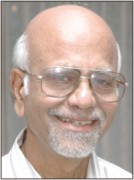‘A glimpse into India’s Scientific Heritage’
By K. Vijaya Kumar, Former Jt. Director of Information & Publicity
 This is actually the title of a rare book which my scientist-friend, Retd. Deputy Director of CFTRI, M.C. Shamanthaka Sastry, walking into my flat the other day with this book in hand, highly recommended me to go through it and return.
This is actually the title of a rare book which my scientist-friend, Retd. Deputy Director of CFTRI, M.C. Shamanthaka Sastry, walking into my flat the other day with this book in hand, highly recommended me to go through it and return.
He briefly mentioned as to how he got this book as a gift (priced Rs. 2,000, pages 200) during his visit to Varanasi on his way back from Nepal in 2007, from a Sanskrit scholar Chamu Krishna Sastry of Samskrita Bharati (who conceived the idea of the book), whom he accidentally met on the banks of Ganga. I am, indeed, thankful to my friend Sastry for his gesture in loaning this valuable book. Later on, about its contents.
Well, I went down with my memory lane over 60 years ago as a high school student in dilemma whether to choose Science or Arts for my future course. My parents thought I was not that intelligent to study Science and myself losing courage, opted for Arts. But I have no regrets as I have developed a scientific temper over the years. Regret is that I did not study Sanskrit but satisfaction is Hindi was second language in my degree class.
Scientific temper
India became the first country in 1976 to include in its Constitution — Article 51A — making it a duty of every citizen to develop scientific temper with humanism. Pandit Jawaharlal Nehru in his book ‘Discovery of India’, as way back in 1946, wrote on scientific temper “as a way of life, a process of thinking, a method of acting and associating with our fellow men.”
In this context, I have to appreciate the initiative of my friend Arjuna Deva of Prajavani and former Chairman of Media Academy, in bringing out a Kannada monthly (Jaana) since 16 years, which devotes to create scientific temper among readers.
Sanskrit & scientific heritage
The ancient Sanskrit language which is considered as divine language is the ‘Soul of India’ and the entire Indian culture is hidden in Sanskrit. Here, I have to recollect how 43 years ago in 1970, late Pandit K.N. Varadaraja Iyengar took a bold and adventurous step and succeeded in launching a Sanskrit newspaper ‘Sudharma’ making Mysore proud to have the only Sanskrit daily in the world. In later years, his son K.V. Sampath Kumar has developed it as e-paper (sudharma.epapertoday.com) having readership across the country and abroad online. One has to remember Founder-Editor late K.N. Varadaraja Iyengar for his contribution in popularising Sanskrit.
About the book
I have a reason to bring this book in my column so that readers will appreciate how India can take pride in its scientific heritage from the time of Vedas and its contribution to the world in the development of science. Chamu Krishna Sastry, All India General Secretary of Samskrita Bharati (Publisher – First published in 2006), who conceived the idea of bringing to light the science available in Sanskrit texts and he vested with ‘Team Nagpur,’ consisting of several scholars of Nagpur in various discipline to select the works and quotes covering the spectrum of science.
Why ‘Pride of India’?
As a preface to the text, Chamu K. Sastry raises, nay, quotes two examples under this title:
The 20th century has seen unprecedented development in knowledge and technology. Car to spacecraft — all have been invented and commercialised in the lifetime of a person. At the end of this epochal growth, humanity is at crossroads:
“The Green Revolution — high yielding varieties of seeds, chemical fertilisers and pesticides — was the blessing which saved India from ruinous famines and equally ruinous Food Import Bills in 1960s. Today the brains in agriculture and chemical technology are searching desperately for ways and means of restoring the soil fertility which has completely eroded by the Green Revolution.”
“Allopathy has taken great strides in the last three decades. Unknowingly, in this avalanche of development, basic tenets of Allopathy have been lost. ‘The doctor ties the bandage but it is He who heals the fracture’ is the axiom that drove the course of treatment that doctors chose some years ago. This axiom is based on the premise that the body has the potential to heal itself. Today, the adverse side effects of allopathic treatment are so acute and widespread that there is a longing for alternate medicines in every part of the world.”
Having raised the above two examples, Chamu K. Sastry writes — “We need an alternate mindset to find innovative solutions. The world is looking to the East inclusive of India for such a solution.”
Certainly, India has solution from its rich vedic scriptures when one goes back to our scientific heritage.
The book for all Indians
Suffice it to conclude with this review on the book by Dr. M.R. Srinivasan, former Chairman, Atomic Energy Commission (which gives in a nutshell the contents of the book): “This elegantly brought out publication presents in a concise way advances made by the Indian civilisation, in the past, in a variety of fields including mathematics, physics, astronomy, civil engineering, mechanical engineering, metallurgy, chemistry and medicines. I recommend the book ‘Pride of India’ to all our citizens so that they can appreciate the rich heritage of science and technology that existed in the past in India.”
e-mail: kumarkv59@gmail.com
source: http://www.StarofMysore.com / Home> Feature Articles / March 22nd, 2013